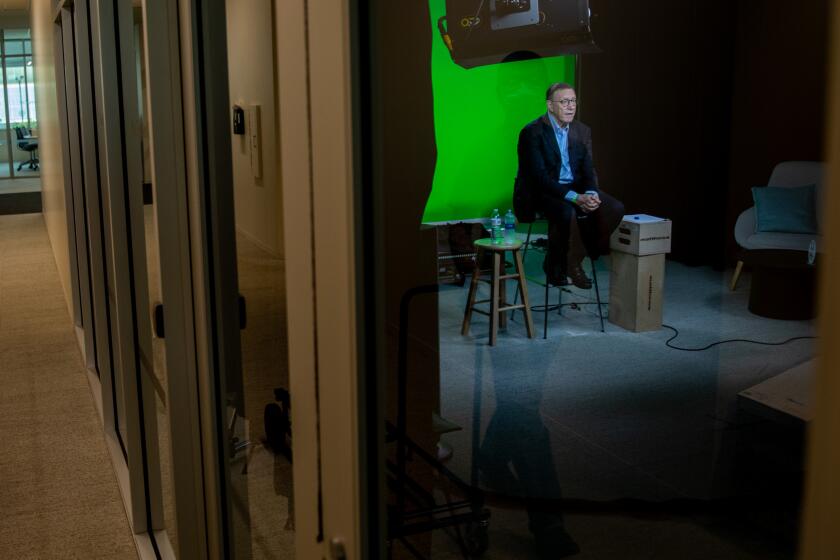L.A. Times shaken by a summer of turmoil and scandals
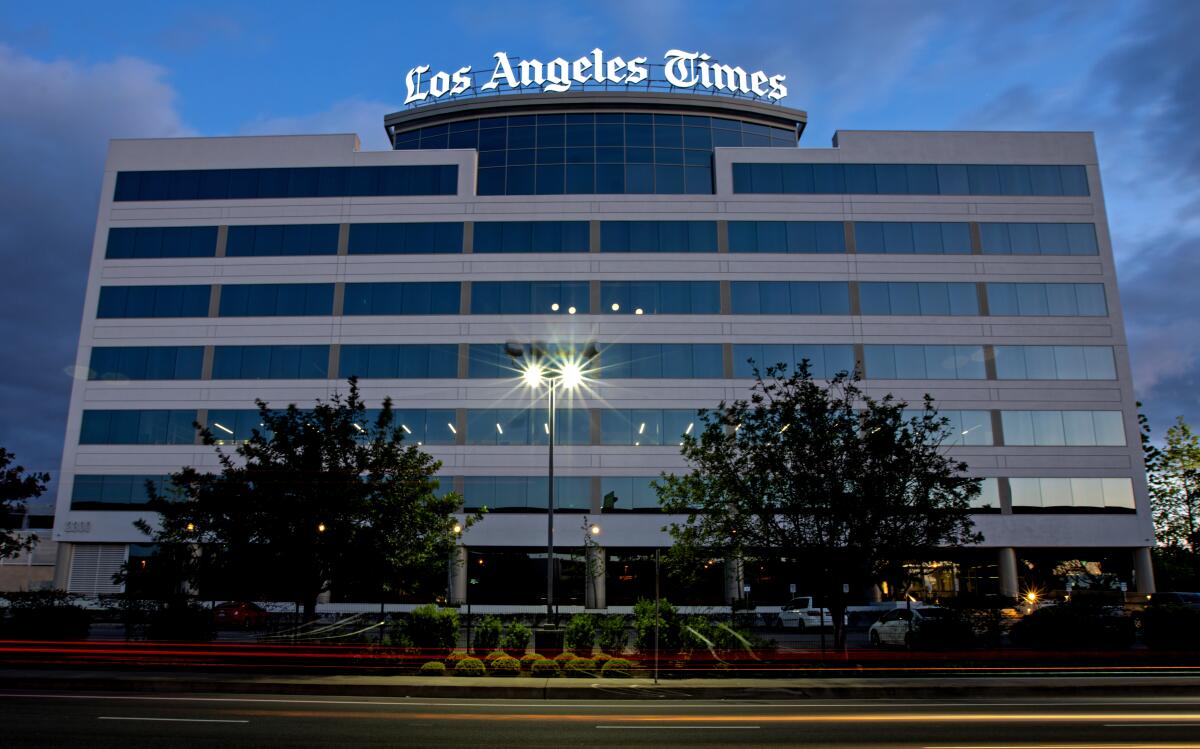
- Share via
On a Friday night last month, Los Angeles Times Executive Editor Norman Pearlstine sent a short email to the newsroom, announcing sports columnist Arash Markazi had resigned.
The columnist had copied information contained in seven stories from other sources, an internal investigation found. Pearlstine said “for the record” clarifications were added to each of the articles.
But there was more to the story. For a year and a half, veteran sports writers had been roiled by Markazi’s penchant for lifting prose from press releases and other sources, his cozy relations with publicists and his social media posts that extolled businesses, including a Las Vegas luxury hotel.
Markazi’s departure was the latest in a series of scandals that has engulfed the newsroom and led to an extraordinary reshuffling atop The Times. Since early last year, six prominent editors have been either pushed out, demoted or had responsibilities reduced because of ethical lapses, bullying behavior or other failures of management.
The disciplinary actions have not quelled the furor in a newsroom already facing a painful self-examination over race. Pearlstine, under fire, acknowledged mistakes and defended his record. He’s not stepping down but said he hoped to soon accelerate succession planning with the paper’s owner, Dr. Patrick Soon-Shiong.
“Although the world has changed in the last six months, my values remain the same,” Pearlstine said. “I still believe that I’m a principled editor, always trying to do what’s best. That’s why I’m here.”
Two years after the Los Angeles Times reverted to local ownership, the country’s largest metropolitan daily newspaper is facing a painful internal reckoning over glaring deficiencies and missteps regarding race and representation in its pages and its staff.
In 2018, Pearlstine went from leading the search for the new L.A. Times leader to becoming the executive editor himself. The 77-year-old newsman — a former top editor of Time Inc., the Wall Street Journal and Forbes and a senior executive at Bloomberg News — had the gravitas that Soon-Shiong and his wife, Michele B. Chan, were looking for after they purchased The Times and the San Diego Union-Tribune for $500 million. Pearlstine “came out of retirement,” he said, to lead the revival.
He’d be a transitional figure, a seasoned pro who could stabilize the ship and groom a new generation of leaders. But his effort to rebuild The Times, including recruiting high-level editors, replenishing the ranks and revamping the paper’s dated technologies, has been hampered by newsroom turmoil.
Soon-Shiong expressed support for Pearlstine.
“I was completely befuddled by the acrimony that’s been launched at Norm, especially at this stage in his career, where he should be lauded for his contributions to American journalism,” Soon-Shiong said. “I felt he was so valuable to our organization.”
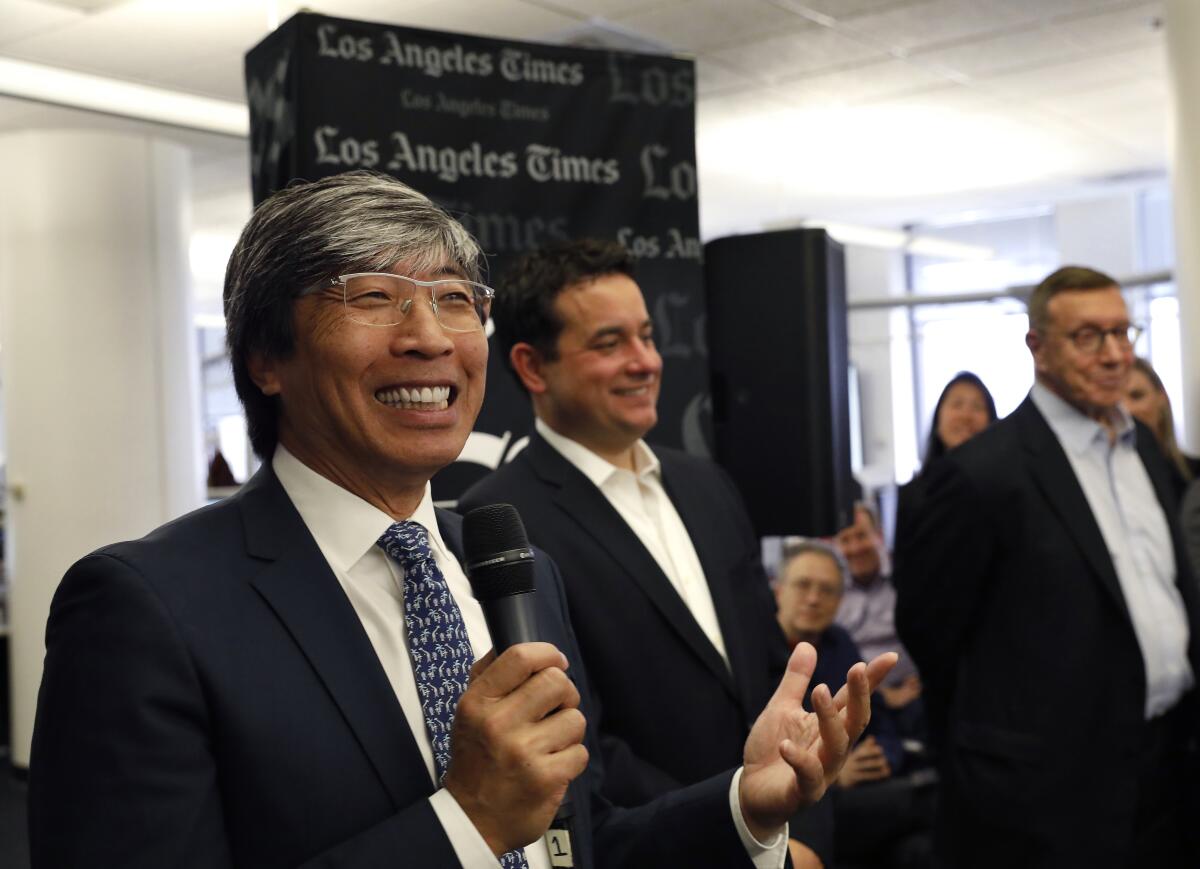
With the Soon-Shiong family’s 2018 acquisition came a renewed sense of hope after a decade of upheaval. But managerial missteps and ethical lapses have contributed to anxiety and distrust in the newsroom, according to interviews with more than 50 current and former staffers. As The Times raced to amplify its journalism, top editors allowed management problems to fester.
“The pain of the past has never really healed,” Image Editor Marques Harper said. “After the sale, we were expecting that a reimagination and rejuvenation would unfold. Instead, we’ve had controversies and scandals.”
The Times has weathered ethics crises before. In 1999, business executives secretly struck a profit-sharing deal with Staples Center, unbeknownst to the newsroom, which produced a glossy 168-page magazine issue devoted to the new arena. The Times’ media critic David Shaw chronicled the transgression.
The Times assigned two reporters to investigate the recent controversies in an effort to be transparent with its readers. “If we’re going to want to shine a light on others, we have to be willing to shine a light on ourselves,” Pearlstine said.
::
The summer of troubles for The Times first boiled over after George Floyd’s killing on May 25 in Minneapolis. Journalists were on edge after agreeing to temporary furloughs because of the plunge in advertising brought on by the novel coronavirus. Staff members took to social media and the communication platform Slack to demand The Times address failures in covering communities of color and retaining journalists from underrepresented backgrounds.
“Younger journalists are demanding more of their managers than previous generations,” said Kelly McBride, chair of the Craig Newmark Center for Ethics and Leadership at the Poynter Institute. “Management teams across all of journalism are figuring this out. It is not unique to the L.A. Times.”
Criticism about institutional racism was soon joined by outrage over accusations of ethical violations and managerial wrongdoing. Two sections of the newspaper became flash points: Food and Sports.
By early 2019, The Times was searching for ways to engage readers beyond its base of older and more affluent Angelenos. Part of the plan was to cover esports, gambling and Las Vegas, a big draw for Southern Californians.
Angel Rodriguez, then assistant managing editor for Sports, thought Markazi, an L.A.-based ESPN writer who covered Las Vegas sports, would be a good fit. With a Hollywood-esque, man-about-town swagger, Markazi had amassed 120,000 Twitter followers and built an Instagram audience captivated by his weight-loss journey.
The paper trumpeted his hiring, but several veteran journalists conveyed their alarm to Rodriguez. Among them was sports enterprise reporter Nathan Fenno.
“Arash appears to have a history of adhering to ethical standards that are different than the ones we abide by,” Fenno wrote in an email to Rodriguez days after Markazi was hired. He referenced behavior that would run afoul of The Times’ ethics guidelines, including “not identifying himself as a journalist … [and] promoting companies he patronizes.”
In July 2010, after Markazi managed to get inside a LeBron James party in Las Vegas, a story he wrote about the experience appeared briefly on ESPN’s internet server before ESPN took it down. The problem, according to ESPN, was that Markazi hadn’t identified himself as a reporter when talking with James or his manager. Markazi was not disciplined.
Managing Editor Kimi Yoshino began looking into the concerns raised by staff. She and Pearlstine called executives at Walt Disney Co., which owns the sports giant, who they said had vouched for Markazi.
“ESPN thought Arash’s flamboyance was a plus — he appealed to the younger fans that ESPN and other sports information outlets must attract if they are to remain viable,” Pearlstine wrote in a Jan. 25, 2019, reply to Fenno.

Trouble arose six weeks into the job, when, with the blessing of his editors, Markazi interviewed Lynn Swann, then USC athletic director. But Markazi was an adjunct professor at USC, and The Times’ ethics guidelines forbid journalists from covering subjects with which they have ties, especially financial.
Staffers were furious. They also objected to what they called Markazi’s promotional social media posts, including shout-outs for a hot hotel on the Las Vegas Strip — the Cosmopolitan. Editors initially shrugged off concerns, several sports writers said.
“They looked at us like we were a bunch of whiny, old dinosaurs who didn’t like this hip, young guy,” columnist Bill Plaschke said. “There was this feeling of, ‘Well, it’s just Sports.’ But it’s not just Sports. Sports are the fabric of the community, and readers deserve our care, our trust and our integrity.”
While editing a Markazi piece in January, Sports Editor Mike Hiserman said he found a plug for Rocket Mortgage in a column about former NFL player Barry Sanders. He said he deleted it. Hiserman then received an email from a public relations executive, who scolded Hiserman, complaining Markazi had agreed to insert a Rocket Mortgage mention in exchange for the Sanders interview, according to a copy of the email.
Hiserman shot back that if a reporter made “a promise he can’t keep, I’m thinking your beef might be with him.” Hiserman said he told Markazi that he couldn’t cut deals like that. Markazi said he didn’t make any such pact.
Markazi’s effusive Twitter posts — including a May 21 tweet saying the Cosmopolitan was offering discounted rooms, “starting at $128” a night — led to problems. In June, he was sent to Las Vegas to cover the reopening of casinos and posted a video, which went viral, showing throngs of people with no masks in the Cosmopolitan. He described the scene in a June 11 travel story about the city’s reopening.
Cosmopolitan casino workers reached out to Markazi in late June, hoping he would expose an outbreak of COVID-19 cases at the resort.
Markazi told his boss, Executive Sports Editor Christian Stone, about the tips June 29. Stone suggested to National Editor Jeffrey Fleishman that the paper send Markazi and a second reporter to investigate. National reporter Melissa Etehad got the assignment and arrived in Las Vegas on July 1.
That day, Vice News published “What Went Wrong at the Los Angeles Times,” which included a passage on Markazi and his Cosmopolitan tweets. Etehad immediately expressed reservations to her editor about working with Markazi. Fleishman said he shared her misgivings, and he quickly messaged Stone, asking if there were any ethical issues regarding Markazi that should concern the paper. Stone told him there were none he was aware of, he said.
Markazi was staying in a suite at the Cosmopolitan, where he enjoyed the perks of his platinum membership, including use of the hotel limo service — a black sedan emblazoned with the Cosmopolitan logo. Stone said he questioned Markazi about his car use and his relationship with the hotel, but was satisfied that he didn’t have a conflict of interest.
Then there was a dustup with the hotel’s publicist who learned Markazi was working on a COVID story, not in town to cover a sports event, according to Etehad and two others familiar with the matter.
Etehad said that during the week in Vegas she grew increasingly uneasy with Markazi’s involvement and discussed the situation with editors. “We felt there were too many questions cropping up to keep Arash on the story,” she said.
Managing Editor Scott Kraft ultimately killed the COVID story, recognizing it had been compromised.
“That really busted our balloon — when the L.A. Times couldn’t get the story out,” said one of the hotel tipsters, who asked not to be identified for fear of losing his job.
The Cosmopolitan declined to comment, citing guest privacy, but in a statement said it takes seriously the safety of guests and staff and had strengthened its “industry leading” sanitization plan.
The Cosmopolitan said: “We hold ourselves to a strict code of ethical practices,” and that points in its guest rewards program are “based solely on an individual member’s personal spend with the resort.”
After 18 members of the Sports staff demanded an investigation, Kraft and Assistant Managing Editor John Canalis began a review of Markazi, who was suspended with pay two days later on July 8. They documented issues with seven stories, including a 2019 March Madness article that contained several paragraphs nearly identical to those contained in a 2018 March Madness piece that Markazi wrote for ESPN. The same quote, from a Las Vegas tourism official, appeared in both pieces.
The editors found other abuses of the paper’s ethics guidelines, including Markazi using his position to get a free yearlong membership to the Los Angeles Athletic Club, according to three people familiar with the matter who were not authorized to comment. Under Times ethics guidelines, which are included in orientation materials given to new employees, journalists are “prohibited from accepting gifts from or giving gifts to news sources, potential news sources or those who seek to influence coverage.”
“Every day, we ask our readers to trust our journalism, and an essential part of that compact is the integrity of our staff — at every level of the organization,” Kraft said. “Our most important responsibility as editors is to pay close attention when ethical concerns are raised and to take decisive action.”
Markazi agreed to resign. He denied seeking to use his position to obtain perks or cutting side deals with publicists. As for his social media posts, he said he lost sight of the fact that the public sees little distinction between “Arash, the person, and Arash, the journalist.”
“The whole thing is heartbreaking,” Markazi said. “I made mistakes, and I walked into a place where I wasn’t welcome.”
Now the top sports editor, Stone, is facing scrutiny over sending Markazi to Vegas to cover the COVID outbreak. Several staff writers anonymously filed a complaint with human resources against Stone, who joined the paper in February, after 27 years at Sports Illustrated.
The complaint alleges that Stone sent Markazi — a former colleague at Sports Illustrated — to Las Vegas to do the COVID-19 story to rehabilitate Markazi’s image. Stone, in an interview, disputed that notion, but acknowledged he was slow to grasp the perception of a conflict.
“It really wasn’t until the Fourth of July weekend, and after the Vice article, that I understood this was a big, big problem,” Stone said. “Should I have recognized that earlier? I wish I had.”
Rodriguez, the former sports editor who hired Markazi, said: “I overestimated his ability to change and live within the rules of the L.A. Times, but ultimately it didn’t work out, and that’s on me.”
Rodriguez also faced criticism for failing to pay for a January 2018 staff party at Santa Anita racetrack, which The Times covers. Rodriguez arranged a farewell party for a longtime sports editor through the track’s PR department, and said the paper would cover the costs. On the day of the party, Rodriguez said he had the flu and didn’t attend.
Rodriguez said he became distracted by his work, preparing to go to the Olympics in South Korea, and simply forgot to pay the bill.
“It was my mistake,” Rodriguez said.

Pearlstine called it a “serious lapse,” adding: “We had an absolute obligation to pay whatever it cost, and we should have paid for it on the day the party occurred.” (The paper tried to make amends this summer by donating $3,000, at Santa Anita’s direction, to a track-affiliated charity for thoroughbreds.)
Another controversy involved short-lived ties to the Pacific-12 collegiate sports conference, a $100,000 deal put together by the Pac-12 and the paper’s ad-sales department in October 2018. The Pac-12 was looking for publicity and The Times wanted to increase its coverage of less-covered college sports, including gymnastics, soccer and water polo. It discussed with the Pac-12 the need to find advertisers who would support such expanded coverage.
Rodriguez was brought into the discussions. “Given the need we have to increase coverage of women’s sports and the desire to get more stories regionally around other sports, we decided to pursue this opportunity,” Rodriguez wrote in a Jan. 2, 2019, email to several members of his staff.
Ultimately, the contract was between The Times and the Pac-12 — not third-party advertisers. And writers began questioning Rodriguez, Yoshino and eventually Pearlstine, asking why the paper would tailor its reporting on an organization it covers in exchange for money. Rodriguez disputed that The Times allowed the Pac-12 to influence coverage.
Pearlstine terminated the agreement. Times spokeswoman Hillary Manning said no money changed hands.
Last fall, Rodriguez switched to a new assignment, overseeing the digital news desk.
While in Sports, he was credited with adding bilingual baseball writers and hiring a younger and more diverse staff. Rodriguez was the only Latino on the masthead of The Times — in a city that is nearly half Latino.
But in August, he stepped down from the masthead, and has since worked on projects such as the digitization of The Times’ 1983 Pulitzer-winning Latino series and efforts to boost Spanish-language content. Today he is no longer directly supervising journalists.
::
Few departments symbolized the paper’s ambitions and the lessons of its recent failings more than Food. Food coverage became a key focus of the newspaper’s transformation under Soon-Shiong, and Yoshino was leading the effort, which attempted to create an all-star team built around the hiring of editor Peter Meehan.
The 2018 death of Times restaurant critic Jonathan Gold left the section without its sage byline and dealt an emotional blow to the entire newsroom, editors and staffers said. Yoshino, seeking a boost, set out to achieve the biggest “get” in a post-Gold era: bringing in Meehan, who had co-founded the subversive food publication Lucky Peach.
With Meehan, the paper set out to relaunch a stand-alone Food section with the kind of splashy art and editorial verve that had defined Lucky Peach. The Times also started building a new test kitchen at the paper’s El Segundo campus. Two new food critics were hired for the nearly impossible job of filling Gold’s shoes: Patricia Escárcega and Bill Addison.
By January 2019, Meehan was named Food editor, although he wouldn’t live in Los Angeles full-time, staying in New York while one of his children finished the school year. Andrea Chang, who had joined the Food section as a reporter the summer before, was named Meehan’s deputy.

Along the way, Meehan developed a reputation as a bullying boss and colleague. For tastemakers and executives above his rank, Meehan was all shine, wowing his own bosses with results, but once he turned to managing below, he could become explosive, according to current and former staffers, some of whom went public recently with their concerns on social media.
In November 2019, Escárcega asked to meet with Yoshino to complain about Meehan’s steepening demands after she returned from parental leave, she recalled. “I said, ‘This guy is like Dr. Jekyll and Mr. Hyde, and I feel like I’m walking on eggshells,’” Escárcega said in an interview. “I cried, and I’ve never cried at work before.”
According to Escárcega, Yoshino told her that Meehan was known to be a generous and kind editor, and that she was sorry Escárcega “didn’t get to see that side of him.”
Seven months later, on July 1, Meehan was gone. The editor resigned after a series of tweets by a New York food writer alleged that he was a tyrannical boss at Lucky Peach and raised questions about his behavior at The Times. The tweets, by writer Tammie Teclemariam, emboldened the Food staff in Los Angeles: They too began posting about their unpleasant interactions with Meehan. The silence was broken.
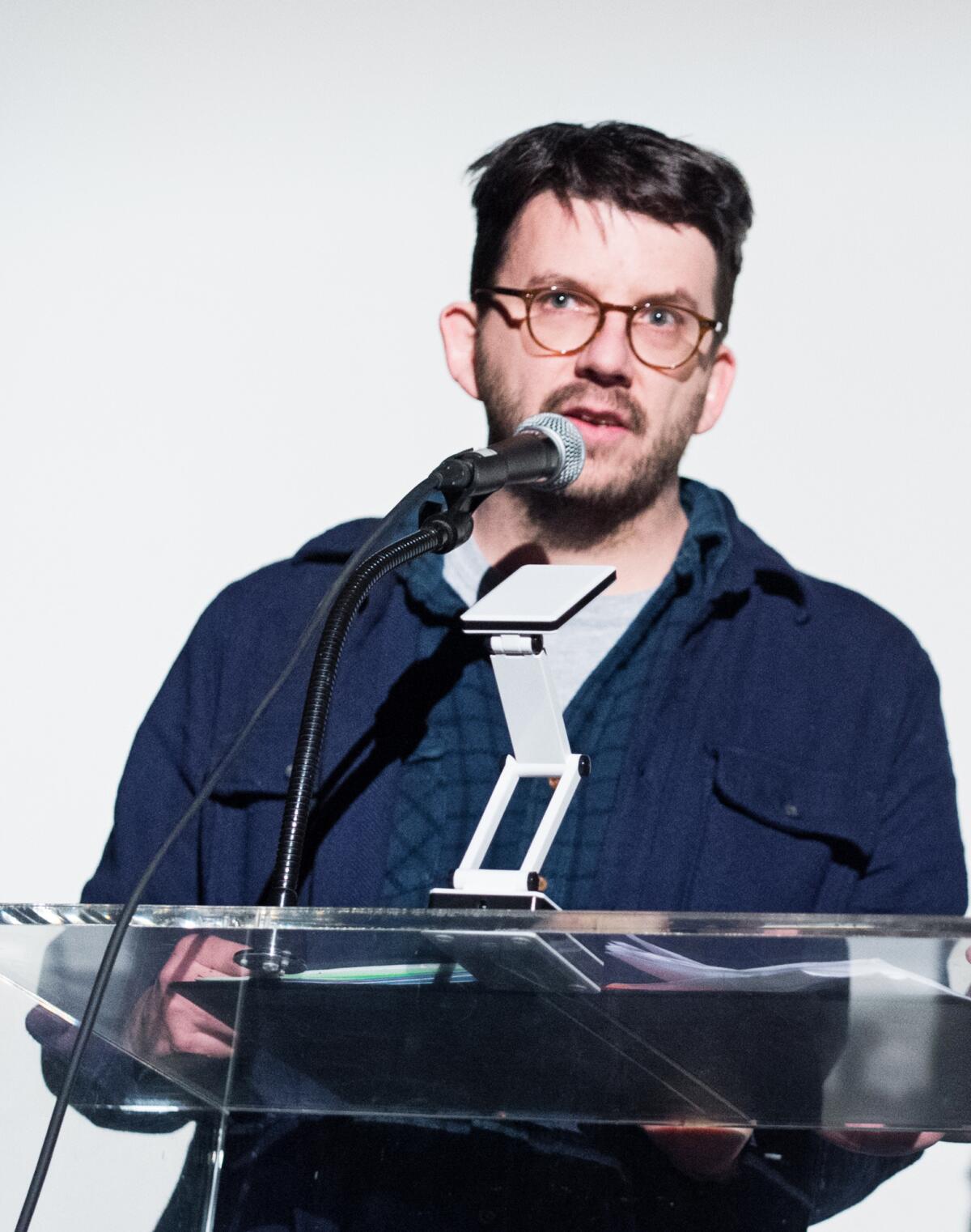
Escárcega said the situation seemed emblematic of a larger problem: the view that certain recently hired stars inside The Times are protected.
Jenn Harris, a staff writer and the acting Food editor before Meehan’s appointment, was quoted in digital food site Eater that she was groped by Meehan during a social outing with other staffers after leaving the Hollywood Bowl, in July 2019.
In the back seat of a car driven by Chang, Harris said, Meehan was intoxicated, leaned over and groped her leg twice. She said Meehan told her he was “pushing boundaries.”
After the incident, Harris, Chang and staff writer Lucas Kwan Peterson, who sat in front, agreed to keep what happened among themselves. Harris told Eater she was “scared” to speak up because Meehan was her boss.
The agreement typified another problem in Food: a cliquish culture. Finding success meant being on Meehan’s good side. According to several members of the Food staff, Chang, Harris and Peterson (who was Meehan’s high school friend) were in the editor’s favored circle.
Yoshino, who oversaw them all, sometimes appeared in the social circle, too.
On Instagram in mid-February, Chang posted a birthday photo at Enrique Olvera’s trendy mezcalería Ticuchi, in the upscale Polanco section of Mexico City. Chang is seated next to her boss Meehan, and on his other side sit Yoshino, Harris and Peterson.
“Posting those kinds of images sends a message to people about who is an insider and who is an outsider,” Escárcega said.
When Meehan resigned, he posted a message on Twitter that said in part: “In my tunnel-vision commitment to making the best thing we could, I lost sight of people and their feelings.” Five days later, the Food staff had a meeting with Pearlstine and The Times’ human resources department — with Yoshino and Chang absent. They demanded an HR investigation.
“We all felt that Kimi would protect Meehan under any circumstances,” said Addison, the co-critic in the section.
Meehan declined to comment.
“I thought we were building a team of people who wanted to be here, working for him,” Yoshino said. “I thought it was a lot of creative tension, which was pushing us to evolve and be better. I see now I was wrong: His staff was scared and traumatized. I deeply regret that I wasn’t a better listener who understood that more fully.”
On Aug. 20, the newsroom received an email from Pearlstine and Nancy Antoniou, California Times’ chief human resources officer, saying an investigation found that “managers failed to prevent or report behavior they knew or should have known was inappropriate.”
Chang came under scrutiny for not reporting the groping incident involving Harris, which she should have done as a manager. Pearlstine announced that Alice Short, a newsroom veteran, would step in as acting Food editor. Chang would be reassigned to Short’s previous post, an editor on Column One, a showcase of narrative journalism.
The move incensed Food staff, who viewed it as a plum gig. Pearlstine said Column One was a temporary stop and Chang would be sent back to being a reporter in Business, where she began her L.A. Times career in 2007.
Yoshino no longer oversees Food. Chang declined to comment.
Meehan’s hiring also pointed to what some see as a blind spot in Pearlstine’s practices. He recruited big-name journalists, often from New York, to make a splash. Some had worked out — others did not, including Meehan and Stuart Emmrich, a former New York Times style editor.
Pearlstine and Emmrich had worked together before, and they bumped into each other at a Committee to Protect Journalists dinner in November 2018. The pair met for coffee the next day, and two months later, Emmrich joined the L.A. Times to lead the Saturday, Image and Travel sections.
But the culture clash was immediate for Emmrich, who inherited a depleted staff of about 10, and employees chafed at his brusque manner. Behind his back, the staff began referring to Emmrich as “The Devil Wears Khakis,” a reference to the demanding fashion editor from the novel and film “The Devil Wears Prada.” Emmrich lasted just nine months.
When reached by phone and told of the description, Emmrich laughed and said, “No comment.”
He’s now a contributing editor at Vogue.
::
Within days of becoming executive editor in June 2018, Pearlstine received an anonymous complaint from several former and current staffers who called a powerful masthead editor, Colin Crawford, a “bully” and a “frat boy.”
Before long, a reporter from another news outlet, BuzzFeed, knew about the anonymous complaint and began sniffing around. (BuzzFeed later dropped the story.)
That was Pearlstine’s introduction into a newsroom culture in which journalists have used their skills to dig up information to expose the failings of managers. Such efforts were instrumental in forcing the ouster of previous top executives, including former Publisher-Editor Davan Maharaj in 2017, former Editor Lewis D’Vorkin in 2018 and former Publisher Ross Levinsohn in 2018.
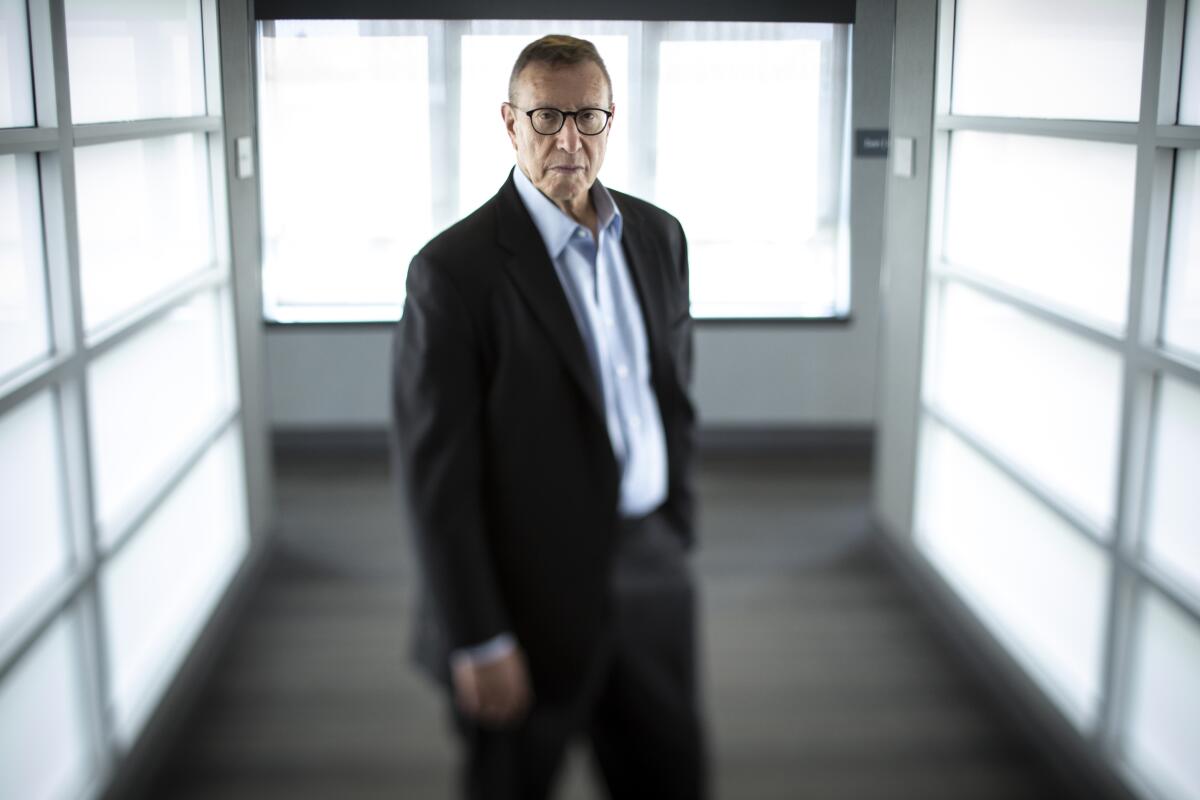
The hard-knuckled campaigns fueled the formation of the Los Angeles Times Guild and helped prompt Tronc to sell The Times to Soon-Shiong. Now Pearlstine and his management team were under the microscope.
An initial human resources review was unable to substantiate the anonymous claims against Crawford, a deputy managing editor who oversaw visuals and photography.
Six months later, a complaint had been lodged with HR, alleging sexual harassment, bullying and retaliation by Crawford, who had been management’s point person to help negotiate the first-ever newsroom guild contract. The company hired an outside investigator, who determined there had been a sexual harassment claim against Crawford in 1992.
Crawford retired abruptly in January 2019. This summer, women in the newsroom circulated a petition demanding a fresh investigation into the matter.
In a Sept. 2 email, HR chief Antoniou wrote: “We found no record of any other allegations of sexual harassment by Crawford being reported to the company in the following 27 years.”
Crawford, in a statement, said “the paper investigated and found nothing to support the claims.”
Among those most critical of management was Pulitzer Prize-winning investigative reporter Paul Pringle, who was part of a grassroots group in the newsroom that maneuvered behind the scenes to force out previous leaders and has doggedly pursued the Santa Anita and Pac-12 controversies.
“We’re trying to put our own house in order,” said Pringle, who was a guild liaison for Sports until last year.
This year, Pringle began looking into a Pearlstine reporting project, which led to two stories in 2019 about a controversial Chinese electronics company, Huawei. Pringle wanted to know whether there was a conflict of interest because Pearlstine had been a consultant before joining The Times. One of his clients was MannLab, whose chairman, inventor Steve Mann, had ties to a second company that claimed to have done business with Huawei. Pearlstine had served as an unpaid advisor to MannLab.
Pringle, his editor Jack Leonard and Pearlstine met in Pearlstine’s office Feb. 13. When questioned about his involvement, Pearlstine erupted in anger. The Times hired an outside law firm to investigate, and said it found no conflict of interest or impropriety by Pearlstine.
“My only relationship with Huawei was that of a journalist, reporting and writing stories. There were no conflicts of interest and no quid pro quo,” he said.
Pringle subsequently filed a labor grievance, alleging that after the incident, Pearlstine began retaliating against him by rejecting story ideas. The company said there was no proof of retaliation.
“Although Pearlstine found the allegations to be absurd and reacted angrily, he then answered Pringle’s questions for nearly an hour,” according to the company’s response to Pringle’s ongoing grievance.
Pringle said: “In every one of these cases, I did everything in the proper way: internally, quietly, on the record, face to face and by the book. If he had done everything by the book, then we wouldn’t be talking.”
On a Friday afternoon in February, soon after the confrontation in Pearlstine’s office, a female reporter delivered a letter to the Culver City biomedical offices of Nant, which is owned by Soon-Shiong.
“The newsroom is increasingly concerned that your investment in The Times is being squandered by masthead leadership that lacks the vision, focus and ethics to guide us to a vibrant, sustainable future,” the anonymous letter read, in part.
Four months later, after an hours-long town hall meeting about racism at the paper, Pearlstine conducted a Zoom meeting with a Metro veteran, Maria La Ganga. At the end of their conversation, Pearlstine made a serious allegation: He accused La Ganga of delivering the anonymous letter to the Nant building.
La Ganga said she had no idea what he was talking about. In fact, she wasn’t the reporter who dropped off the letter. Pearlstine persisted, saying her image was captured on surveillance footage.
Pearlstine declined to comment, saying a grievance settlement related to the incident has been settled. As part of the resolution, Pearlstine apologized for raising the allegation and the specter of surveillance, according to two people familiar with the details who were not authorized to comment.
“I love and value the L.A. Times. ... It’s my home,” La Ganga said. “But the decisions that are being made by some of the top editors do not reflect the views and values of my colleagues in the newsroom.”
Amid the rising friction, multiple outlets began reporting on the paper’s management woes. The leaks of internal material to competitors also raised tensions inside.
“It completely pains me,” Soon-Shiong said of the newsroom leaks. “They have to ask themselves … a very simple question: Am I doing the right thing?”
Soon-Shiong emphasized that staffers need to see themselves as partners with management, not antagonists. And he’s gotten a better view of the situation this summer after he, his wife Michele and their daughter Nika began conversations with the newsroom’s Black Caucus and Latino Caucus, as the paper grapples with its historical mistreatment of people of color.
“We need to listen,” Soon-Shiong said. “The pain was real. People really felt distraught, but I think it was a bit unfairly directed just to management.”
Since the marathon June town hall meeting, The Times has taken steps to address its shortcomings, including mandatory employee training on bias.
It named Kimbriell Kelly, deputy editor for investigations, as incoming Washington bureau chief, the first Black journalist to hold the prestigious newsroom title. Earlier this month, the paper elevated Angel Jennings — the lone Black reporter in the Metro department — to the masthead as the paper’s first Culture and Talent editor.
Soon-Shiong, for his part, said staffers must feel comfortable bringing complaints forward without fear “of any retribution.”
“It’s not good for any of us to continue this squabbling,” Soon-Shiong said. “We’ve got to work together because there’s an opportunity here for us to thrive.”
The paper, he said, will begin a search for a successor to Pearlstine when Pearlstine is ready to step down. Pearlstine said he hoped to have that conversation with Soon-Shiong by year’s end.
“The right person will be the right person when that person shows up,” Soon-Shiong said. “To be honest, we’ve not found or seen that person yet.”
More to Read
Updates
3:29 p.m. Sept. 21, 2020: This post was updated to provide additional details on The Times’ arrangement with the Pac-12, the grievance settlement with Maria La Ganga and to clarify the communications between the Soon-Shiong family and newsroom caucuses.
Inside the business of entertainment
The Wide Shot brings you news, analysis and insights on everything from streaming wars to production — and what it all means for the future.
You may occasionally receive promotional content from the Los Angeles Times.
